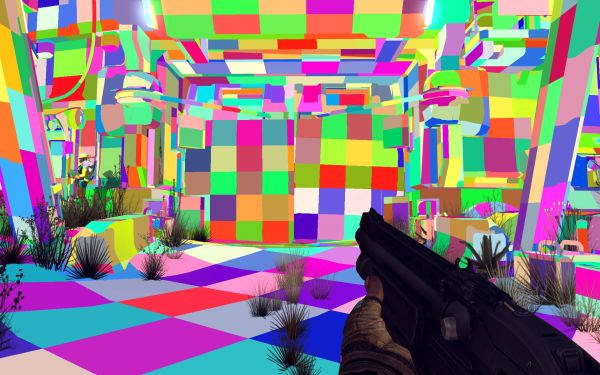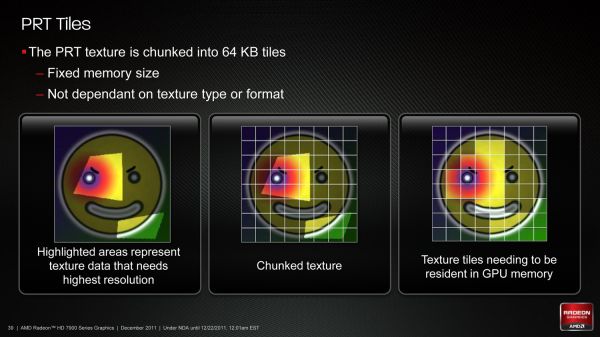AMD Radeon HD 7970 Review: 28nm And Graphics Core Next, Together As One
by Ryan Smith on December 22, 2011 12:00 AM EST- Posted in
- GPUs
- AMD
- Radeon
- ATI
- Radeon HD 7000
Partially Resident Textures: Not Your Father’s Megatexture
John Carmack’s id Software may not be the engine licensing powerhouse it was back in the Quake 3 days, but that hasn’t changed the revolutionary nature of his engine designs. The reason we bring this up is because there’s a great deal of GPU technology that can be directly mapped to concepts Carmack first implemented. For id Tech 4 Carmack implemented shadow volume technology, which was then first implemented in hardware by NVIDIA as their UltraShadow technology, and has since then been implemented in a number of GPUs. For id Tech 5 the trend has continued, now with AMD doing a hardware implementation of a Carmack inspired technology.
Among the features added to Graphics Core Next that were explicitly for gaming, the final feature was Partially Resident Textures, which many of you are probably more familiar with in concept as Carmack’s MegaTexture technology. The concept behind PRT/Megatexture is that rather than being treated as singular entities, due to their size textures should be broken down into smaller tiles, and then the tiles can be used as necessary. If a complete texture isn’t needed, then rather than loading the entire texture only the relevant tiles can be loaded while the irrelevant tiles can be skipped or loaded at a low quality. Ultimately this technology is designed to improve texture streaming by streaming tiles instead of whole textures, reducing the amount of unnecessary texture data that is streamed.
Currently MegaTexture does this entirely in software using existing OpenGL 3.2 APIs, but AMD believes that more next-generation game engines will use this type of texturing technology. Which makes it something worth targeting, as if they can implement it faster in hardware and get developers to use it, then it will improve game performance on their cards. Again this is similar to volume shadows, where hardware implementations sped up the process.
In order to implement this in hardware AMD has to handle two things: texture conversion, and cache management. With texture conversion, textures need to be read and broken up into tiles; AMD is going with a texture format agnostic method here that can simply chunk textures as they stand, keeping the resulting tiles in the same format. For AMD’s technology each tile will be 64KB, which for an uncompressed 32bit texture would be enough room for a 128 x 128 chunk.
The second aspect of PRT is managing the tiles. In essence PRT reduces local video memory to a very large cache, where tiles are mapped/pinned as necessary and then evicted as per the cache rules, and elsewhere the hardware handles page/tile translation should a tile not already be in the cache. Large tomes have been written on caching methods, and this aspect is of particular interest to AMD because what they learn about caching here they can apply to graphical workloads (i.e. professional) and not just gaming.
To that end AMD put together a technology demo for PRT based on Per-Face Texture Mapping (PTEX), a Disney-developed texture mapping technique that maps textures to polygons in a 1:1 ratio. Disney uses this technique for production rendering, as by constraining textures to a single polygon they don’t have to deal with any complexities that arise as a result of mapping a texture over multiple polygons. In the case of AMD’s demo it not only benefits for the reasons that Disney uses it, but also because when combined with tessellation it trivializes vector displacement, making art generation for tessellated games much easier to create. Finally, PRT fits into all of this by improving the efficiency of accessing and storing the Ptex texture chunks.
Wrapping things up, for the time being while Southern Islands will bring hardware support for PRT software support will remain limited. As D3D is not normally extensible it’s really only possible to easily access the feature from other APIs (e.g. OpenGL), which when it comes to games is going to greatly limit the adoption of the technology. AMD of course is working on the issue, but there are few ways around D3D’s tight restrictions on non-standard features.

















292 Comments
View All Comments
SlyNine - Friday, December 23, 2011 - link
Not really, If Nvidia didn't handicap the CPU version of physx so bad than I'd be fine with it, But Nvidia purposely made the CPU version of phsyx worse totally gimped.CeriseCogburn - Thursday, March 8, 2012 - link
I agree, but that's the way it guy. The amd fans don't care what they and their reviewers pull, and frankly the reviewers would recieve death threats if they didn't comply with amd fanboy demands....So when nvidia had ambient occlusion active for several generations back in a driver add, we were suddenly screamed at that shadows in games suck.... because of course amd didn't have that feature...
That's how the whole thing is set up - amd must be the abused underdog, nvidia must be the evil mis-implementer, until of course amd gets and actual win, or even any win even with 10% IQ performance cheat solidly in place, and any other things like failed AA, poor tessellation performance, no PhysX, etc, etc, etc...
We just must hate nvidia for being better and of course it's all nvidia's fault as they are keeping the poor red radeon down....
If amd radeon has " a perfectly circular algorithm " and it does absolutely nothing and even worse in all games, it is to be praised as an advantage anyway.... and that is still happening to this very day... we ignore shimmer until now, when amd 79xx has a fix for it.... etc..
Dude, that's the way it is man....
Nvidia is the evil, and they're keeping the radeon down...
They throw around money too ( that's unfair as well - and evil ...)
See?
So just pretend anything radeon cannot do that nvidia can doesn't count and is bad, and then make certain nvidia is cut down to radeon level, IQ cheat, no PhysX, AA not turned on, Tesselation turned down, default driver hacks left in place for amd, etc....
Then be sure to cheer when some price perf calc ignoring all the above shows a higher and or lower and card to have a few cents advantage... no free game included, no eyefinity cables... etc.
Just dude... amd = good / nvidia=evil ...
Cool ?
shin0bi272 - Thursday, December 22, 2011 - link
Since I cant edit my comments I have to post this in a second comment instead.According to the released info, Nvidia’s Next Gen flagship GK-100/GK-112 chip which will feature a total f 1024 Shaders (Cuda Cores), 128 texture units (TMUs), 64 ROP’s and a 512-bit GDDR5 Memory interface. The 28nm Next Gen beast would outperform the current Dual chip Geforce GTX590 GPU.
shaboinkin - Thursday, December 22, 2011 - link
Can someone tell me why GPUs tend to have much more transistors than a CPU? I never knew why.Boushh - Thursday, December 22, 2011 - link
Basically it has to do with the difference between programs (= CPU instructions) and graphics (= pixels):A program consists of CPU intructions, many of these instructions depend on output from the previous instruction, Therefore adding more pipelines that can work on the instructions doen't realy work.
A picture consists of pixels, these can be processed in parrallel. So if you double the number of pipelines (= pixels you can work on at the same time), you double the performance.
Therefore CPU's don't have that many transistors. In fact, most transistors in a CPU are in the cache memory not in the actual CPU cores. And GPU's do.
Of course this is hust a simple explenation, the through is much much more complex ;-)
Boushh - Thursday, December 22, 2011 - link
That last line should read:'Of course this is just a simple explanation, the reality is much much more complex'
Reminds me to yet again vote for an EDIT button !!!! Maybe as a christmas present ? PLEASE !!!
shaboinkin - Thursday, December 22, 2011 - link
Interesting...Do you know of a site that goes into the finer details?
Mishera - Wednesday, December 28, 2011 - link
If you're looking for something to specifically answer you question the checking different tech sites. I think realworldtech addressed tis to a degree. Jon Stokes at arstechnica from what I heard wrote some pretty good articles on chip design as well. But if it's a question on chip architecture, reading some textbooks is your best bet. I asked a similar question in the forums before and got some great responses just check my posts.I add to what Boushh said in that for the type of information they process, it's beneficial to have more performance (and not just for graphics). That's why Amd has been pushing to integrate the gpu into the CPU. That's also to a degree show the different philosophy right now between intel and Amd in multicore computing (or the difference between Amd's new gpu architecture vs their previous one).
What it comes down to is optimizing chip design to make use of programs, vice versa. There really is now absolute when dealing with this.
MrSpadge - Thursday, December 22, 2011 - link
It's not like - as stated several times in the article - AMD is wrong about the power target of the HD7970, if they mean the PowerTune limit. Think of it as "the card is built to handle this much heat, and is guaranteed not to exceed it". That doesn't forbid drawing less power. And that's exactly what the HD6970 does: it's got the same "power target", but it uses less of its power budget than the HD7970.Like CPUs, whose real world power consumption is often much less than the TDP.
MrS
Ryan Smith - Thursday, December 22, 2011 - link
PowerTune is a hard cap on power consumption. Given a sufficient workload (i.e. FurMark or OCCT), you can make the card try to consume more power than it is allowed, at which point PowerTune kicks in. Or to put this another way, PowerTune doesn't kick in unless the card is at its limit.PowerTune kicked in for both the 6970 and 7970. In which case both cards should have be limited to 250W.